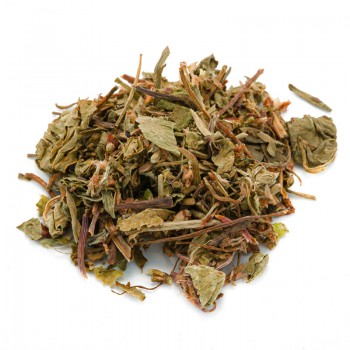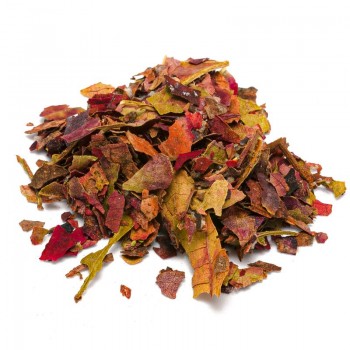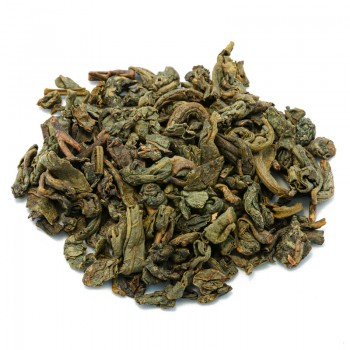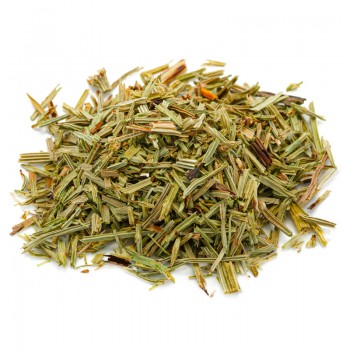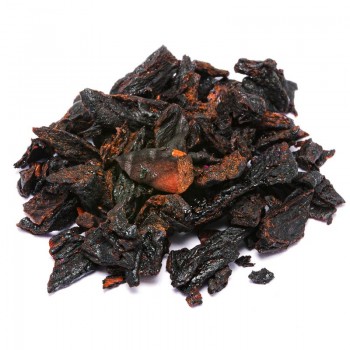Green tea pineapple and cinnamon
Green tea, cinnamon and pineapple have beneficial properties for our body. A tea enriched with these ingredients is a great source of antioxidants, and provides one of the most exquisite draining and slimming herbal teas.
It can help support digestive function, counteract water retention and regulate blood sugar levels.
Properties and benefits
It is an infusion rich in natural antioxidants, given that green tea contains active ingredients such as flavonoids, catechins, polyphenols, EGCG, vitamin C.
The antioxidants in green tea they can help prevent the damage that free radicals cause to cells, also reducing inflammation in the body.
Green tea does not undergo the fermentation process of black tea, which destroys the phenolic substances of the leaves. In this way, the antioxidant molecules are preserved, which help to achieve the balance of body weight and the drainage of liquids. This combination of ingredients with green tea, however, is in great demand among those who want to lose weight. Green tea can help support weight loss, being composed of caffeine - a substance that increases metabolism and temporarily reduces appetite.
But that's not all: the catechins contained in green tea are studied for their fat-burning effect.
Epigallocatechin-gallate polyphenol (EGCG) acts on substances called catecholamines, as an agent that initiates thermogenesis and lipogenesis, to promote weight loss. Green tea is therefore said to be a thermogenic ingredient, that is, it promotes an increase in body temperature and acceleration of the metabolism.
This metabolic process produces heat in adipose and muscle tissue, increasing oxygen consumption. Thermogenesis translates into faster fat burning and, consequently, promotes possible weight loss in less time. In essence, the action on catecholamines releases energy and makes it available for immediate use in the body, avoiding accumulations in fat. The presence of pineapple and cinnamon is due to the fact that they are equally useful ingredients for burning fat and speeding up the metabolism.
In addition, both green tea and pineapple promote a draining effect, which counteracts water retention, swelling and the appearance of cellulite. They facilitate the expulsion of retained liquids, among the causes of swelling and heaviness in some areas of the body.
In this slimming herbal tea, the calendula also provides draining and purifying qualities, counteracting water retention and anti-cellulite. The cinnamon, in this mix, can influence the management of sugars in the blood. It slows down the body's ability to absorb carbohydrates and helps less body fat to be deposited in the body. It is also being studied for its useful property in stimulating the correct release of the hormone insulin, which helps keep glucose levels under control. These virtues make cinnamon a perfect ally for losing weight.
The nutritional benefits of this pineapple and cinnamon green tea also include minerals, such as the high manganese content; an element that supports bone health and the immune system, and helps regulate glucose (increases fat and carbohydrate metabolism).
These ingredients also protect the health of the digestive system. They favor the assimilation of food during the digestive process, regulating intestinal transit. Cinnamon prevents gas formation and bloating.
Moreover, another advantage of green tea with cinnamon is its ability to protect the cardiovascular system, by supporting the balance of cholesterol and triglyceride levels.
EGCG polyphenol promotes the correct metabolism of lipids, preventing the oxidation of LDL cholesterol - high density lipoproteins.
Origins and History of cultivation
Sencha tea is one of the oldest teas consumed in the world.
It is a green tea, which comes from the famous Camellia Sinensis plant. It differs in cultivation and processing from other types of tea; the leaves are grown in direct sunlight, taken from the first and second harvest, choosing from the younger and higher quality ones. Sencha is usually prepared with whole steamed leaves less than one metreIn order to avoid oxidation, they are rolled up and dried to then be infused.
It is a tea widespread in Japan, where about 80% of the processing comes from, which makes it golden and greenish, with a refreshing and sweet aroma. It was introduced in Japan in the 15th century by visiting Chinese Buddhist monks. Since its introduction it has been highly regarded by samurai and feudal nobles. It has been part of the Japanese tea ceremony for centuries.
Sencha green tea is used for herbal teas, for cooking and in cosmetic products. It has various benefits recognized in ancient times by traditional medicine, including its relaxing properties on the mind and body. We know several sencha green tea varieties that are grown for their different flavors and effects. Among the main ones is Shincha tea, which comes from the first harvest of sencha in spring – the freshest green tea leaves. The Kabusecha variety is grown, that is tea grown in full shade for seven to ten days; gives a slightly sweeter taste.
Finally, the Gyokuro variety is known, similar to Kabusecha tea but shaded for twenty days. This process results in a much sweeter tasting tea, which is the most expensive green tea in Japan. This basic ingredient is joined by cinnamon, a spice that comes from the Indian subcontinent. It has been used for thousands of years, and we know that as early as 2000 BC. it was considered a valuable commodity in the Middle East.
Among its many uses, in addition to the food one as a spice with a warm and sweet taste, cinnamon in the ancient world was also used as a perfume for embalming. It was brought to Europe by Arab traders, and soon became popular. Until the most important geographical discoveries, traders managed to keep its origin secret, to protect their monopoly and be able to sell it at high prices.
It was expensive since it was transported overland, on roads that were difficult to navigate. For this reason, cinnamon was considered a status symbol in Europe, and was highly appreciated for its ability to preserve meat during the winter. With the discovery of America, Portuguese explorers looked for the spice and found it in Ceylon (Sri Lanka). Today, the most widely available types of cinnamon are Ceylon cinnamon and cassia cinnamon (it comes from Indonesia and has a stronger smell than Ceylon cinnamon). Pineapple too is a tropical fruit, in this exotic and draining herbal tea, which historians believe originated in Brazil, developed early in tropical and subtropical America
It was imported into Europe after colonization, and Christopher Columbus and his crew members are thought to have tasted this fruit. It spread in Europe in warm climates, appreciated above all by noble and wealthy families. In more recent times, entrepreneur James Dole did much to popularize the fruit through his pineapple plantations in Hawaii, creating the convenient canned pineapple we all know.
Plant and flowers
Green tea comes from the Camellia Sinensis plant. Camellia is native to eastern Asia, it represents a genus that includes about 250 species of evergreen trees and shrubs, belonging to the Theaceae family.
Camellia sinensis (sometimes called Thea sinensis), even reaches 9 meters in height tall, but is generally grown reduced to a low bush, often pruned to encourage the development of young tea leaves. The flowers are fragrant, yellow and about 4 cm wide.
Ananas comosus is a perennial plant of the Bromeliaceae family, known for its edible fruit. The plant displays stiff leaves, 30 to 40, closely spaced in a rosette and borne atop a fleshy stem. About 15-20 months after planting, in commercial varieties, an inflorescence forms on a flower stalk, light purple in color. The flowers become fleshy and merge to form the pineapple fruit, which ripens 5-6 months after flowering. The fruits range from 1 to 2 kg in weight.
Cinnamon (Cinnamomum verum), is a bushy evergreen tree of the Lauraceae family. The spice we know comes from its dried inner bark. Various related species are also cultivated as a source of cinnamon, including Chinese cassia (Cinnamomum cassia), Vietnamese cinnamon (C. loureiroi), Indonesian cinnamon (C. burmannii) , and the Malabar cinnamon (C. citriodorum).
The cinnamon tree grows in moist, well-drained soils, reaching about 15 meters in height. The oval leaves have margins - when young they are red and mature to a deep green. The small flowers are found from vgreenish to yellow, while the fruit is a dark drupe.
Nutritional values Green tea pineapple and cinnamon
Green tea contains high quantities of polyphenols, antioxidant substances, including the important EGCG (Epigallocatechin gallate). In addition to the chemical substances known as methylxanthines (caffeine, theobromine, theophylline). Furthermore, it makes vitamin C and group B vitamins (thiamin, riboflavin, niacin) available; minerals such as iron, magnesium, potassium, zinc. In addition to the minerals mentioned, also present in cinnamon, this spice contains substances such as aromatic monoterpenes (including cinnamic aldehyde), with antioxidant activity. Pineapple is rich in manganese, bromelain, dietary fiber and vitamin C.
How to prepare pineapple and cinnamon green tea
Green tea with pineapple and cinnamon is obtained by placing about 3-5 grams of the infusion preparation in a cup (250 ml) with water at 80 °C.
Leave it to infuse for 2 to 3 minutes, before drinking the draining and slimming herbal tea. Add honey or sugar, if desired.
Pineapple and cinnamon green tea: side effects and contraindications
Green tea can cause side effects if you do not respect the recommended doses – given that the excessive caffeine content can cause discomfort.
If consumed in excessive quantities, green tea causes nervousness, anxiety, insomnia, rapid heart beat. Furthermore, green tea could affect the functioning of the thyroid gland, or cause liver fatigue . For this reason, it is advisable to consult a specialist in case of chronic pathologies.
It is advisable to be cautious about the ingredients of the herbal tea, to be evaluated both for any allergies of which you are aware, and for pregnant and breastfeeding women.











 No reward points for this product.
No reward points for this product.


